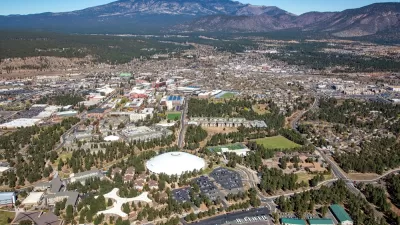The Arizona Daily Sun details the curious case of subdivision development, private utilities, and skyrocketing utility rates that linger as an effect of the last development cycle of boom and bust.
Emery Cowan reports on the quickly escalating cost of water in an Arizona subdivision known as Flagstaff Meadows, which is served by a utility called Utility Source. The utility is requesting a rate increase from state regulators that would, if allowed, quadruple the price of water for residents in the last nine years.
In Flagstaff Meadows, Cowan reports, such high water rates would be too much for some homeowners to bear. Unfortunately, the Arizona Corporation Commission, the publicly elected body that regulates private utilities, predicted many of the development's current problems back in 2004 when the subdivision was first built.
According to Cowan: "While Utility Source's case is unique in many ways, several key issues are the product of larger development challenges that are pervasive across the state: small developer or landowner-owned utilities with costs that overwhelm a small ratepayer base, subdivisions left half-built after developers went bankrupt during the housing bust and a reliance on groundwater that, at least in northern Arizona, is difficult and expensive to access and pump."
Arizona has more than 400 small utilities, according to the article, which is an unusually high number. So many small utilities leads to problems with economies of scale, expertise on the part of the utilities, and trouble dealing with impacts arising from the persistence of zombie subdivisions.
FULL STORY: Water cost increases hit Bellemont subdivision

Maui's Vacation Rental Debate Turns Ugly
Verbal attacks, misinformation campaigns and fistfights plague a high-stakes debate to convert thousands of vacation rentals into long-term housing.

Planetizen Federal Action Tracker
A weekly monitor of how Trump’s orders and actions are impacting planners and planning in America.

In Urban Planning, AI Prompting Could be the New Design Thinking
Creativity has long been key to great urban design. What if we see AI as our new creative partner?

King County Supportive Housing Program Offers Hope for Unhoused Residents
The county is taking a ‘Housing First’ approach that prioritizes getting people into housing, then offering wraparound supportive services.

Researchers Use AI to Get Clearer Picture of US Housing
Analysts are using artificial intelligence to supercharge their research by allowing them to comb through data faster. Though these AI tools can be error prone, they save time and housing researchers are optimistic about the future.

Making Shared Micromobility More Inclusive
Cities and shared mobility system operators can do more to include people with disabilities in planning and operations, per a new report.
Urban Design for Planners 1: Software Tools
This six-course series explores essential urban design concepts using open source software and equips planners with the tools they need to participate fully in the urban design process.
Planning for Universal Design
Learn the tools for implementing Universal Design in planning regulations.
planning NEXT
Appalachian Highlands Housing Partners
Mpact (founded as Rail~Volution)
City of Camden Redevelopment Agency
City of Astoria
City of Portland
City of Laramie





























